If you’ve ever watched Finding Nemo, you’ve probably wondered which fish species the characters are based upon in real life.
It turns out that the animators at Pixar really did their homework in researching marine fish for the movie, making their depictions appear amazingly similar to their real-life counterparts.
But while the fish in the story may look similar to fish in the wild, they don’t necessarily always behave like them! For example, some of the friendliest fish in Finding Nemo are actually quite aggressive both in the ocean and in aquariums.
So let’s learn some fun facts about fish that became the movie stars of Finding Nemo, and explore which ones make the most suitable species to keep at home (for experienced fish keepers only)!
What Kind of Fish Are Nemo, Marlin, and Coral in Finding Nemo? – Clownfish
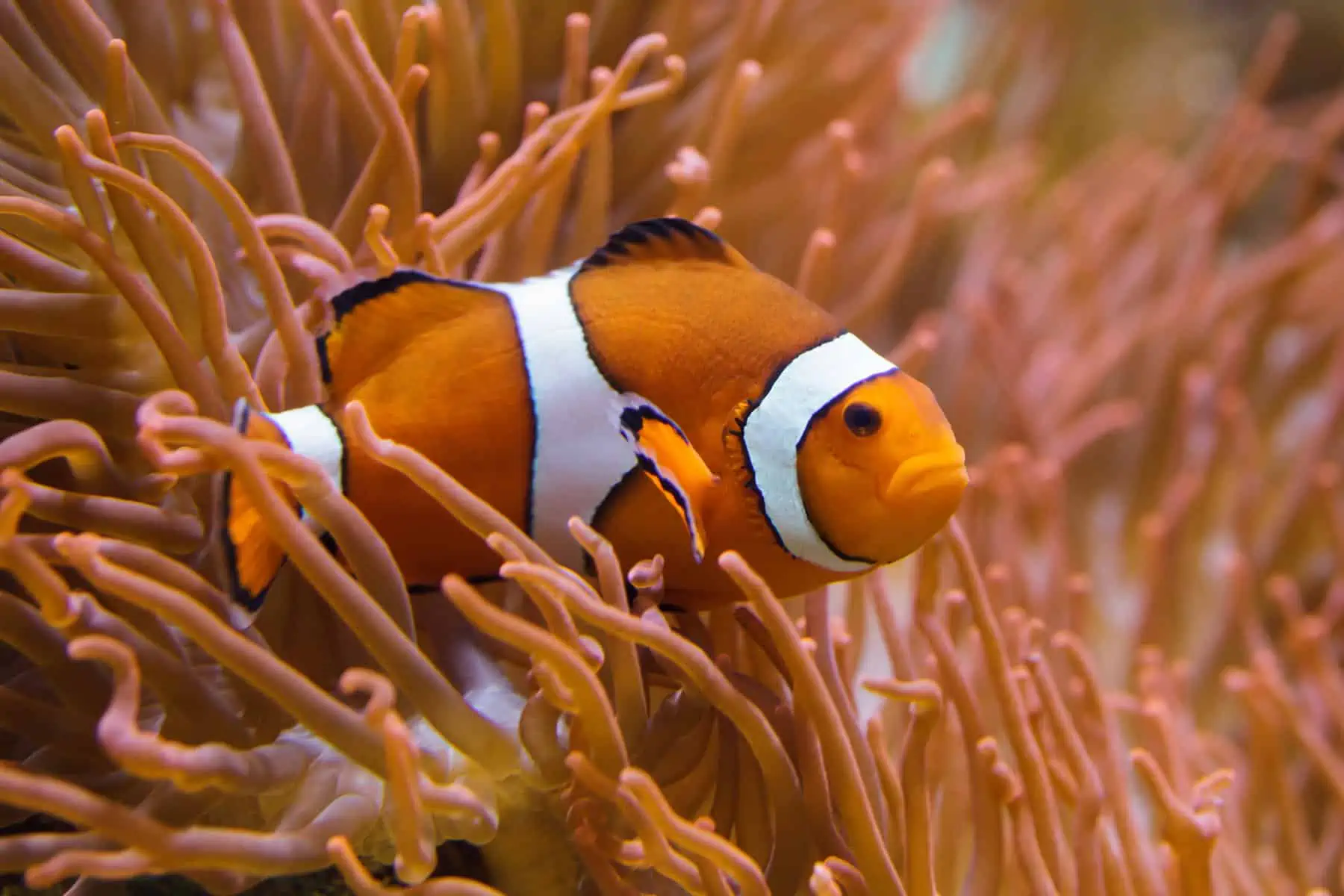
The title character of the movie ‘Nemo’ is a Clownfish. So of course his father Marlin, and his mother Coral are Clownfish, too!
Since the movie, Clownfish have become crazily popular in home aquariums. Everyone wanted their own little Nemo or Marlin to keep at home. But what many movie fans didn’t realize is that the saltwater reef tanks that Clownfish require are definitely not for beginners!
Even though Clownfish are sometimes referred to as ‘hardy fish’ that are ‘easy to keep’, it’s essential to understand this is only in the context of a reef aquarium. In reality, no reef fish is easy to keep compared to freshwater fish like goldfish, neon tetras, or betta fish!
Furthermore, there are dozens of different species of Clownfish, and some of them are easier to keep than others. The Ocellaris and Percula Clownfish are said to be two of the easier Clownfish species to keep, but Maroon Clownfish and Tomato Clownfish are more territorial, aggressive fish.
All of this means that even though Clownfish are incredibly cute, they’re definitely not suitable for an impulse buy. Even if pet store representatives encourage you, please understand that you need plenty of experience with freshwater tropical fish before trying to keep marine fish!
What Kind of Fish Is Dory in Finding Nemo? – Royal Blue Tang
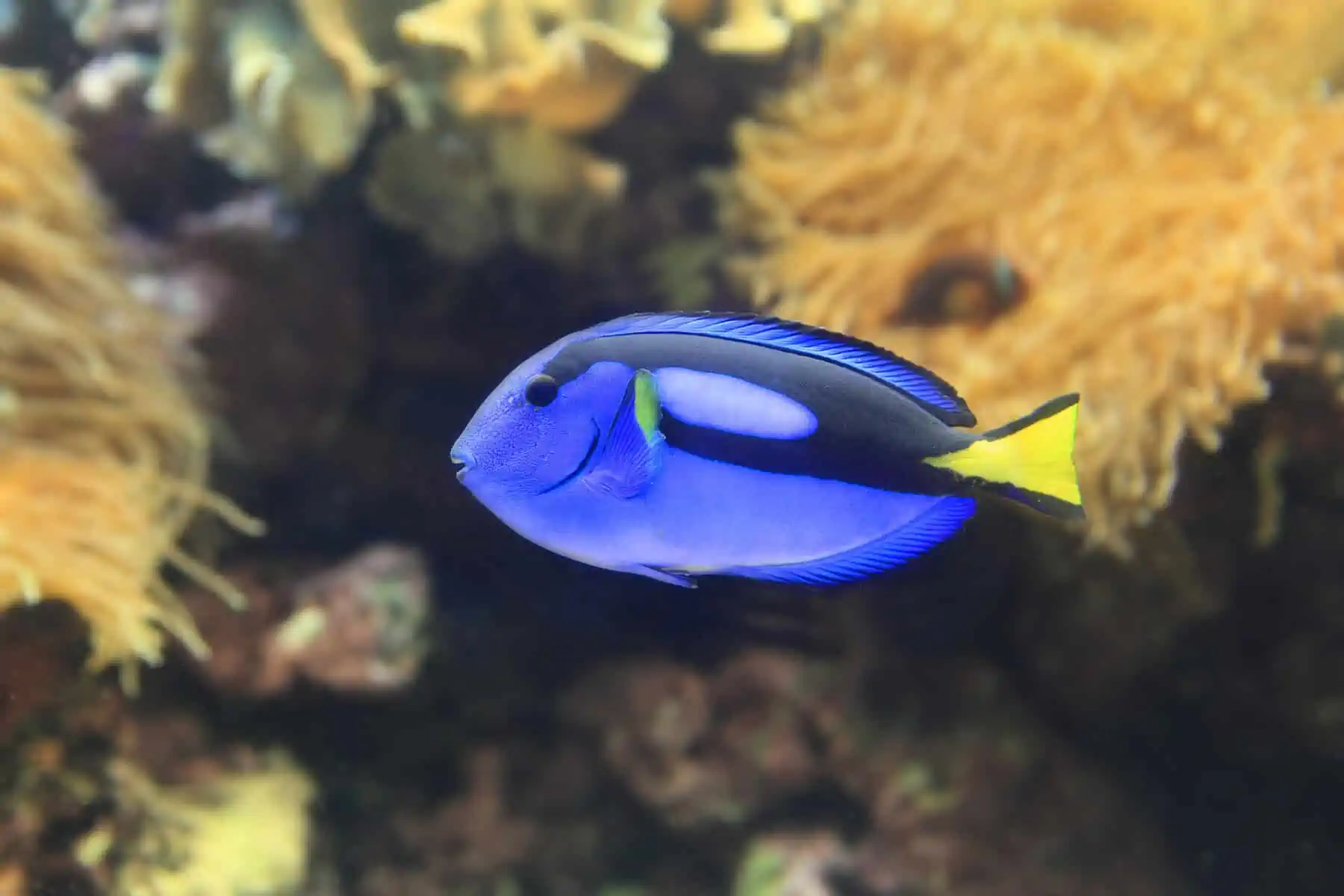
When Marlin is chasing after the boat that’s taken Nemo away, he bumps into Dory, an endearing blue and yellow fish with short-term memory loss.
The character Dory is based on the Royal Blue Tang, otherwise known as Blue Hippo Tang, Regal Tang, or simply, Blue Tang. Tangs are a popular group of fish for reef tanks, with stunning colors and striking shapes.
But once again, tangs are not the easiest family of fish to keep, and the Royal Blue Tang is especially tricky. Blue tangs need exceptionally high quality, stable water quality to thrive, and can also grow to a rather large 12 inches long.
Some easier tangs to keep are explored in our dedicated article on tang fish. They include the yellow tang, kole tang, and scopas tang.
What Kind of Fish Is Tad in Finding Nemo? – Longnose Butterfly Fish

When Nemo goes to school, he meets a bright yellow, disc-shaped fish with a long snout named ‘Tad’. The character is based on the beautiful Longnose Butterfly Fish.
Longnose Butterfly Fish are iconic tropical marine fish that are popular in the saltwater aquarium trade. They grow to around 8.5 inches long and need plenty of free swimming space as well as rocky places to hide.
But because Longnose Butterfly Fish are renowned for eating coral, they’re not normally advised for reef tanks. Instead, they’re more often kept in ‘Fish only’ aquariums. They’re typically fairly peaceful towards other fish but can be aggressive towards one another, and other butterfly fish.
Yellow Longnose Butterfly Fish have a huge native range that extends from Hawaii, all the way through the Eastern Pacific, and the Indian Ocean, to the Red Sea in Africa.
What Kind of Fish Is Sheldon in Finding Nemo? – Sea Horse

Another member of Nemo’s school gang is Sheldon, a Sea Horse. Sea horses are a diverse family of fish, with 46 species counted to date.
Seahorses can range from 0.6-13.8 inches in length and can be found around the world in temperate, as well as tropical seas. Seahorses appear to be incredibly intelligent and social creatures.
Did you know that seahorses create long-lasting monogamous bonds with one another? After long courtship dances, females place their eggs in the male’s oviduct, leaving him to gestate the eggs and give birth to up to a thousand babies. Incredible!
Seahorses also have highly dexterous tails with which they can hold onto each other, or onto passing pieces of seaweed to hitch a ride on ocean currents!
Seahorses are not so easy to keep in aquariums and require a specialist diet. They’re best left to advanced fish keepers only.
What Kind of Fish Is Mr.Ray in Finding Nemo? – Spotted Eagle Ray

Not many Finding Nemo fans would forget Mr.Ray, the funny and charismatic school teacher of Nemo, and his fellow young fish friends.
Mr.Ray is based on the Spotted Eagle Ray, a huge, and exquisitely beautiful type of ray in the Eagle Ray family.
Mature Spotted Eagle Rays grow up to 15 feet long (including their long, whip-like tail), and attain a 9-foot wingspan. This makes them too large for home aquariums, but their beautiful patterns make them a popular attraction at public aquariums.
Another way that humans can enjoy Spotted Eagle Rays is to go diving with them in the wild. It’s been observed that these giant marine creatures seem to return our curiosity with them by slowing down and having a good look at us, too!
What Kind of Fish Is Gill in Finding Nemo? – Moorish Idol

Now, when Nemo gets thrown into the tank in the dentist’s office, there is a gang of tank mates waiting for him. The leader of the gang is Gill, a large, black-and-white striped fish with a beautiful disc-like shape.
To begin with, we wonder if he might be up to no good, but he turns out to be a good-hearted character. In real life, it turns out that the Moorish Idol, the fish that Gill is based on, is one of the trickiest fish to keep in reef tanks.
Because Moorish Idols are notoriously picky eaters and can be destructive in captivity, many saltwater aquarists have opted to keep other species that look similar but are easier to keep.
Schooling Bannerfish, and Pennant Coral fish are two examples of reef fish that have remarkably similar outlines and markings to Moorish Idols but are less fussy in reef tank setups.
Gill and the rest of the ‘Tank Gang’ appear again in Pixar’s sequel to Finding Nemo, ‘Finding Dory’.
What Kind of Fish Is Bubbles in Finding Nemo? – Yellow Tang
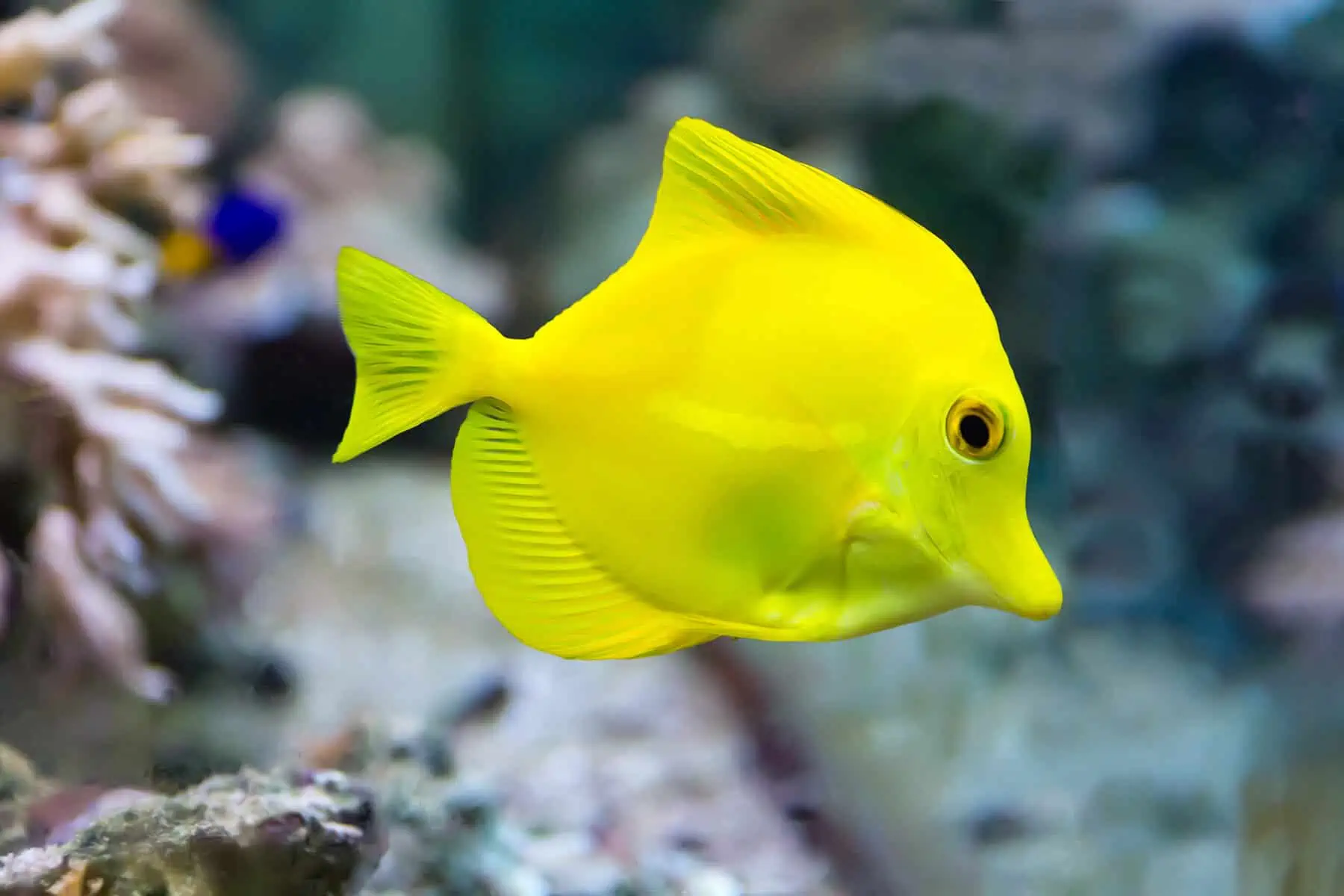
We just mentioned that yellow tangs are easier to keep than blue tangs, now guess what type of fish Bubbles is?
Yes, the beautifully bright yellow ‘Bubbles’ who shares Nemo’s fish tank in the dentist’s office is the famous yellow tang.
Yellow tangs tend to be hardier than many other tangs because these days they’re almost always bred in captivity. Since they’re familiar with a captive environment from day one, they tend to be more forgiving of minor mistakes by the saltwater fishkeeper.
Don’t go thinking that yellow tangs are a beginner’s fish by any means though! They can be fairly aggressive fish towards other yellow tangs and other similar fish in their family.
Some fish keepers, however, have had success keeping a school of them by introducing them all together at a young age.
Yellow tangs are certainly an eye-catching reef species, but probably won’t get obsessed with bubbles in their tank like their famous depiction in the movie!
What Kind of Fish Is Gurgle in Finding Nemo? – Royal Gramma
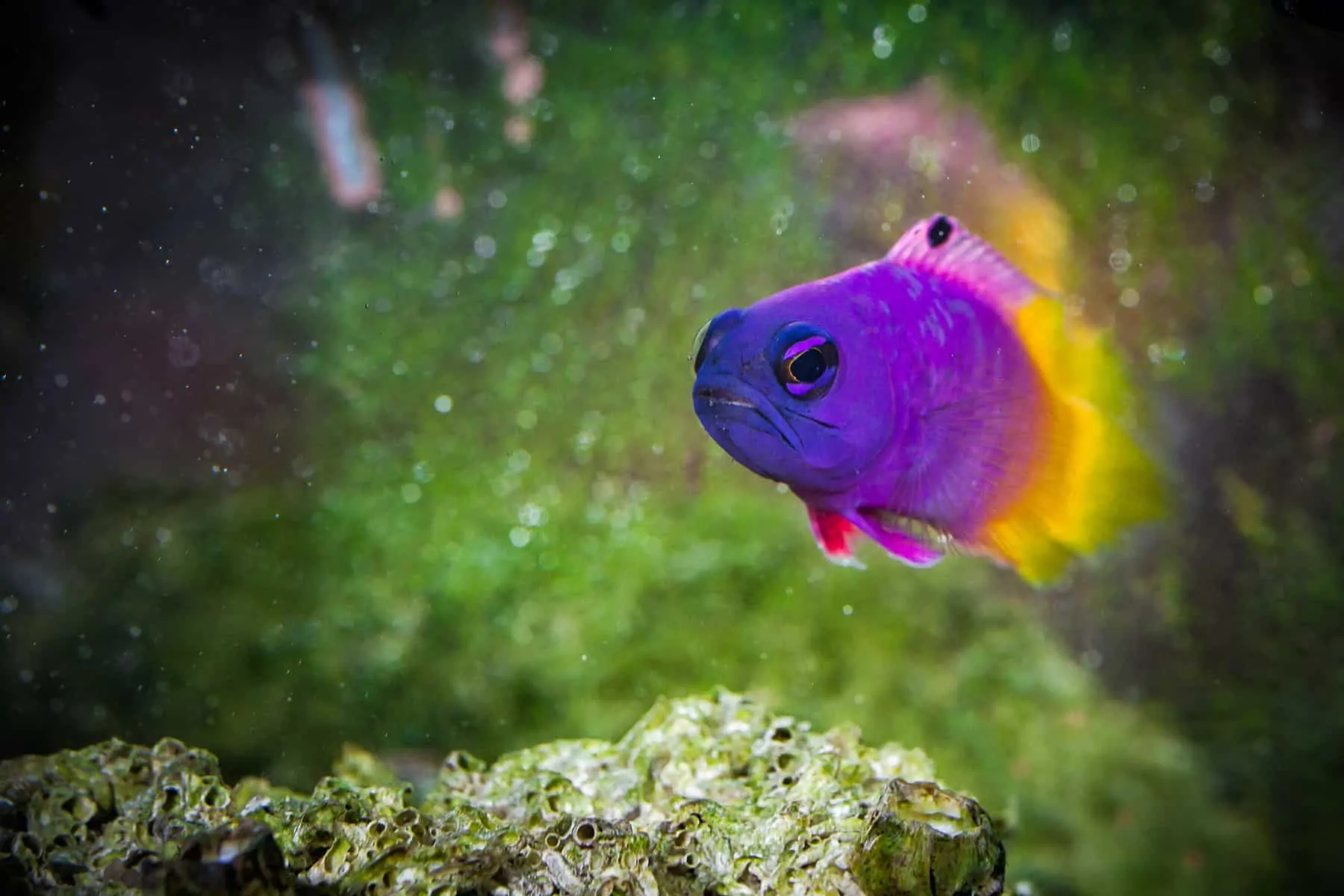
Now, for a slightly easier fish to keep. If you were wondering who that beautiful yellow and purple fish ‘Gurgle’ was in Finding Nemo, the answer is a ‘Royal Gramma’.
Royal grammas are slender, 4-inch-long fish belonging to the basslet family. In their native habitats in the Western Atlantic and Caribbean oceans, they tend to live in caves, emerging mainly for feeding on zooplankton and crustaceans.
Because of their small size, robust character, and relatively peaceful nature, Royal Grammas make a suitable choice for an experienced fish keeper setting up their first reef tank.
Like many reef fish, however, royal grammas can be territorial and may chase other fish away from their favorite crevices and hiding places. This means you’ll need a large enough aquarium for each fish to stake out its own territory.
What Kind of Fish Is Bloat in Finding Nemo? – Porcupine Puffer Fish

Bloat is another member of the Tank Gang. Remember the one that puffs up and starts floating every time he hears any disturbing news?
Well, that isn’t so different from his real-life equivalents in the Porcupine Puffer Fish family. Also known as ‘blowfish’, ‘globefish’, and ‘balloon fish’, these names all indicate the defensive behavior of this extraordinary family of slow-moving sea creatures.
Every time the porcupine puffer fish feels threatened by a potential predator, it swallows air or water to puff itself up, making it too large for many predatory fish to swallow. Secondly, when it is inflated, its spines become erected, making it a painful proposition for the predator to take on.
Some members of the porcupine puffer fish family also possess a third line of defense which is incredibly toxic inner organs that are over a thousand times more deadly than cyanide!
In the wild, porcupine puffer fish use their sharp, parrot-shaped jaws to feed on shellfish and sea urchins. In an aquarium, they need similarly hard shells to keep their teeth ground down, and can easily chew through coral reefs, aquarium tubing, and aquarium heaters!
This potentially destructive behavior, combined with their large mature size of 20 inches, makes them a fish for the most experienced marine tank specialists only.
What Kind of Fish Is “Deb” in Finding Nemo? – Four-Stripe Damselfish

The four-striped damselfish in Finding Nemo ‘Deb’ is a kind-hearted character with an imaginary sister named ‘Flo’.
But the real-life version of Deb is often less amicable in the aquarium! Striped damselfish, are small, hardy fish, but they are also some of the most aggressive members of the damselfish family!
Striped damselfish come from Indonesian and Australian coral reefs, including the Great Barrier Reef where the movie begins. They travel about in schools, feeding on fish fry, crustaceans, and algae.
Better types of damselfish for beginners include the more peaceful Green Chromis, Yellowtail Blue Damselfish, and Azure Damselfish.
What Kind of Fish Is Jacques in Finding Nemo? – Pacific Cleaner Shrimp

Remember the French shrimp ‘Jacques’ in Nemo’s fish tank that can’t help himself from performing his compulsive cleaning habits? He’s based on the Pacific Cleaner Shrimp, a crustacean with an insatiable instinct for keeping things clean.
But Pacific Cleaner Shrimp, or ‘Skunk Cleaner Shrimp’ don’t only clean algae. These symbiotic organisms also clean the bodies of various marine fish!
Removing parasites, as well as cleaning teeth and wounds, these crustaceans will sometimes live alongside large species such as moray eels to offer their cleaning services on a regular basis!
Pacific Cleaner shrimp are very useful in home aquariums for keeping glass and coral free from algae, and for keeping fish free from parasites.
They’re difficult to breed in captivity, so are caught from wild populations, leading some to raise concerns about their conservation status.
What Kind of Star Fish Is Peach in Finding Nemo? – Leather Sea Star
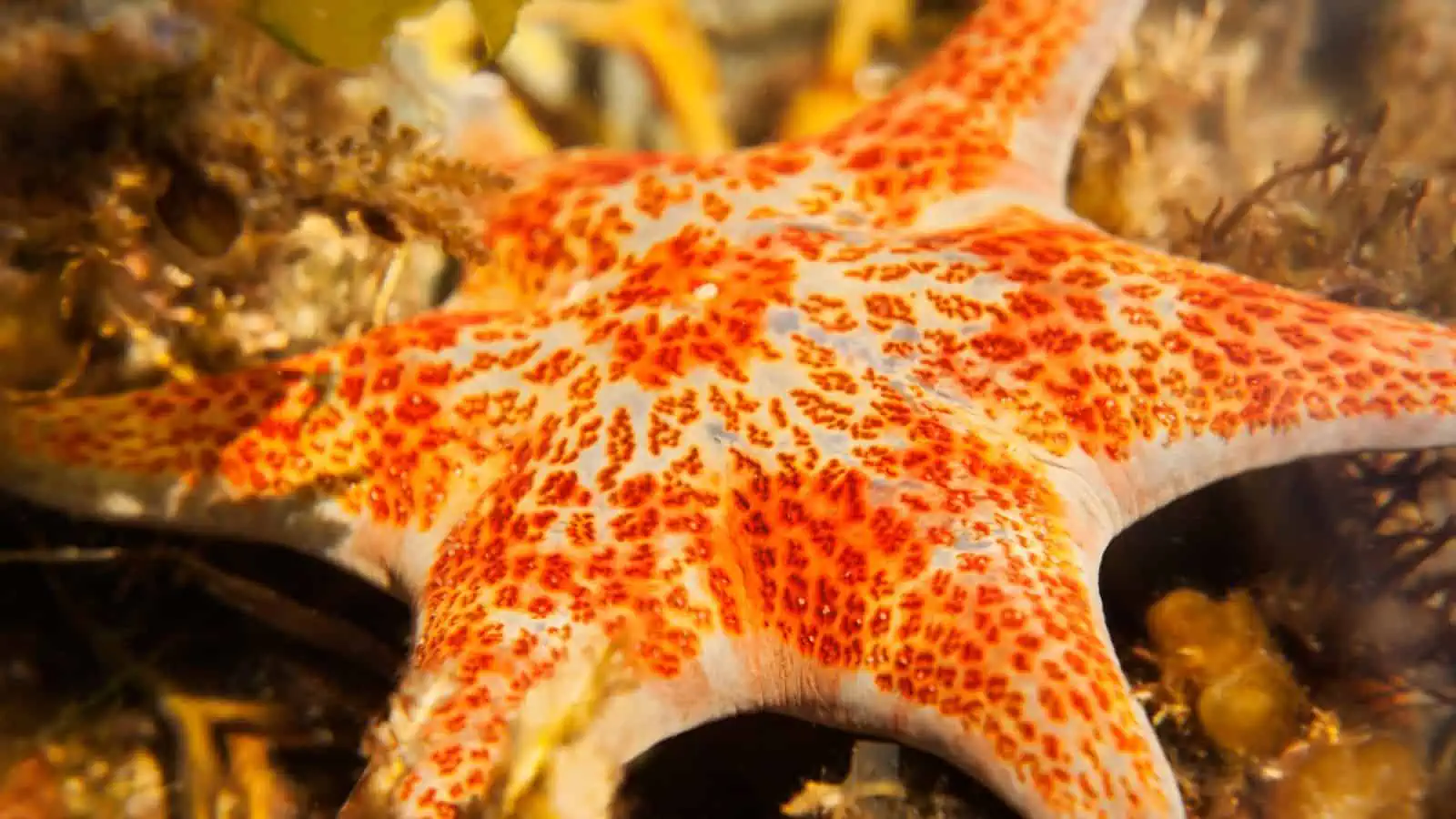
If there’s one tank mate in Nemo’s Sydney aquarium that you won’t forget in a hurry, it’s probably ‘Peach’, the ‘Leather Sea Star’ starfish.
In the wild, Leather Sea Stars live off the Pacific coast of North America. Because their range extends from North Mexico to Alaska, they’re much more tolerant of cold water compared to most of the other species on our list.
Leather sea stars feed on algae, Sea Urchins, Sea Sponges, Sea Cucumbers, and other invertebrates. They use a garlic-like odor to ward off potential predators!
Although they’re sometimes kept in public aquariums, they’re rarely kept by hobbyists at home.
What Kind of Fish Is Bruce in Finding Nemo? – Great White Shark

You probably guessed that Bruce, the split-personality vegetarian shark in the movie is based on the infamous Great White Shark.
Growing up to 19 feet long and weighing more than 4,000 lbs, Great Whites are one of the largest and most fearsome fish in the world. These powerful swimmers have a diverse diet, ranging from seals and sea lions to bony fish, dolphins, and small whales.
Although great whites are feared by people around the world for their ‘man-eating’ reputation, shark attacks are incredibly rare. Over the past 70 years, there have been an average of less than 5 people killed by shark attacks worldwide each year.
One reason that you’ll never see Great White Sharks in public aquariums is that they’re too big and aggressive. The Monterey Bay Aquarium was the only public aquarium to display a Great White, but it lasted less than 200 days. The shark attacked its tank mates and was subsequently released back into the wild.
What Kind of Fish Is Anchor in Finding Nemo? – Hammerhead Shark

Another member of the vegetarian shark gang is ‘Anchor’, a hammerhead shark.
Hammerheads are one of the most recognizable and iconic types of shark, and there are 9 known species worldwide.
Many, if not all, hammerhead shark species are considered endangered in the wild, and it’s possible that more species are yet to be discovered. Great Hammerhead Sharks are the largest of the clan, and can sometimes match the enormous 19ft length of a Great White Shark.
Hammerheads are more aquarium-friendly than Great Whites, though, and are displayed in many public aquariums around the world. Some people understandably feel that keeping such large oceanic predators in captive environments is rather cruel.
Hammerheads have been known to occasionally attack humans, although no fatalities have been recorded.
What Kind of Fish Is “Chum” in Finding Nemo? – Mako Shark

The final member of the vegetarian shark gang is ‘Chum’, a Mako Shark.
Mako Sharks are extremely widespread mackerel sharks that can be found in temperate and tropical seas from the United Kingdom to Madagascar, to New Zealand. They can grow up to a maximum length of 3.8 meters long, and weigh up to 1,200 pounds.
With top speeds of 45 miles per hour, these torpedo-shaped hunters hold the prestigious record for being the fastest shark in the world, and one of the fastest of all the world’s fish, too.
Mako sharks have been trialed in public aquariums several times but these free-spirited, athletic fish have never exceeded 5 days in captivity!
Final Thoughts
Let’s just reiterate once again how, despite being very cute, marine fish species are notoriously difficult to keep in home aquariums and are strictly for experienced fish keepers only.
If you’re new to the hobby, we’d highly recommend you start off getting a freshwater tropical tank and host beginner aquarium fish such as neon tetra, zebra danios, and rasboras before considering saltwater fish.
You’ll be glad to know that freshwater tanks are much cheaper to set up, too!


